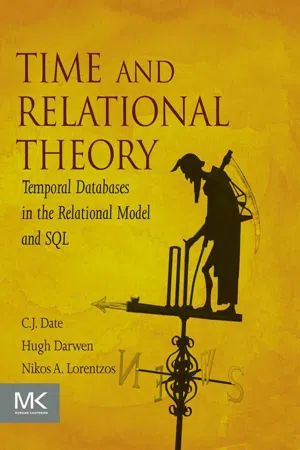
Time and Relational Theory
Temporal Databases in the Relational Model and SQL
- 560 pages
- English
- ePUB (mobile friendly)
- Available on iOS & Android
Time and Relational Theory
Temporal Databases in the Relational Model and SQL
About This Book
Time and Relational Theory provides an in-depth description of temporal database systems, which provide special facilities for storing, querying, and updating historical and future data. Traditionally, database management systems provide little or no special support for temporal data at all. This situation is changing because:
- Cheap storage enables retention of large volumes of historical data in data warehouses
- Users are now faced with temporal data problems, and need solutions
- Temporal features have recently been incorporated into the SQL standard, and vendors have begun to add temporal support to their DBMS products
Based on the groundbreaking text Temporal Data & the Relational Model (Morgan Kaufmann, 2002) and new research led by the authors, Time and Relational Theory is the only book to offer a complete overview of the functionality of a temporal DBMS. Expert authors Nikos Lorentzos, Hugh Darwen, and Chris Date describe an approach to temporal database management that is firmly rooted in classical relational theory and will stand the test of time.
This book covers the SQL: 2011 temporal extensions in depth and identifies and discusses the temporal functionality still missing from SQL.
- Understand how the relational model provides an ideal basis for taming the complexities of temporal databases
- Learn how to analyze and evaluate commercial temporal products with this timely and important information
- Be able to use sound principles in designing and using temporal databases
- Understand the temporal support recently added to SQL with coverage of the new SQL features in this unique, accurate, and authoritative reference
- Appreciate the benefits of a truly relational approach to the problem with this clear, user friendly presentation
Frequently asked questions
Information
Part I A Review of Relational Concepts
Types and Relations
Keywords
The Running Example

TYPE SNO … ;
TYPE PNO … ;
TYPE NAME … ;
VAR S BASE
RELATION
{ SNO SNO , SNAME NAME, STATUS INTEGER , CITY CHAR } KEY { SNO } ;VAR SP BASE
RELATION
{ SNO SNO , PNO PNO } KEY { SNO , PNO } FOREIGN KEY { SNO } REFERENCES S ;Table of contents
- Cover image
- Title page
- Table of Contents
- Copyright
- Dedication
- About the Authors
- Preface
- Part I: A Review of Relational Concepts
- Part II: Laying the Foundations
- Part III: Building on the Foundations
- Part IV: SQL Support
- Appendixes
- Index